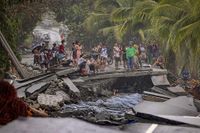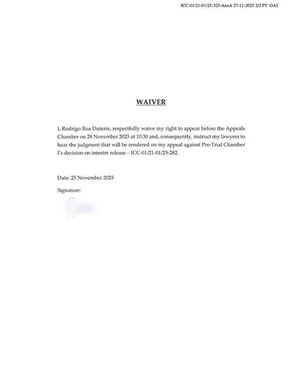In early November 2025, the Philippines was battered by a succession of powerful storms, with super-typhoon Fung-Wong making landfall on November 9 and causing devastation across the archipelago. The storm, which struck just days after Typhoon Kalmaegi, brought gale-force winds, flash flooding, landslides, and storm surges that affected millions, underscoring the country’s vulnerability to recurring natural disasters.
According to the AFP and GlobalData, Fung-Wong’s arrival in Aurora province packed winds of 185 kilometers per hour and gusts reaching 230 km/h. The typhoon killed at least two people and displaced 1.4 million residents across Luzon, the nation’s most populous island. The eastern coastal town of Dipaculao, for instance, was left without power, and rescue teams faced daunting conditions as they began clearing debris and assisting evacuees.
The destruction was widespread. The Department of Agriculture estimated that Fung-Wong caused around PHP968 million (US$16.8 million) in damage to the agriculture sector alone. Flash flooding in Catanduanes province killed at least one person, while another died in eastern Samar province when her house collapsed. By November 25, nearly 320,000 people remained in evacuation shelters, and at least 1,000 homes were damaged. More than 325 domestic and 61 international flights were canceled, stranding over 6,600 commuters and cargo workers in ports as the Philippine Coast Guard prohibited ships from venturing into rough seas.
President Ferdinand Marcos Jr. declared a state of emergency on November 21, citing the devastation caused by Typhoon Kalmaegi—which had killed at least 224 people just days earlier—and the expected damage from Fung-Wong. The two storms were among about 20 typhoons that strike the Philippines each year, a frequency that has more than doubled for super-typhoons over the past two decades, according to national meteorological data cited by GlobalData.
Scientists warn that climate change is intensifying these storms. As reported by AFP, warmer oceans allow typhoons to strengthen rapidly, and a warmer atmosphere holds more moisture, resulting in heavier rainfall. The World Bank estimates that average annual storm-related damage in the Philippines reaches about US$3.5 billion.
Amid the chaos, international and local responses mobilized quickly. The Philippine government requested disaster relief assistance from the United States, which was approved by U.S. Secretary of Defense Pete Hegseth. About 500 U.S. military personnel—including Marines from the 15th Marine Expeditionary Unit, the 3d Marine Expeditionary Brigade, the U.S. Air Force, and the U.S. Navy—were deployed to Clark Air Base and Camp Aguinaldo. Their mission: deliver life-saving aid to the hardest-hit regions.
Marine Cpl. Efrain Avila-Castro, who usually works a desk job at Camp Pendleton, found himself on the front lines of disaster relief. He helped deliver 10,000 meals to affected Filipinos, working at Clark Air Base and Virac Airport on Catanduanes, where Fung-Wong had made landfall. "All of this was outside my job description," Avila-Castro told Los Angeles Times. "It was super exciting. At first, I felt a little nervous, but my purpose was in front of me—the Filipino people—it was a constant reminder, this is what I’m here for."
The food packs, provided by the Philippine government, were enough to feed a family of five for three days. Avila-Castro and his fellow Marines executed "combat offloads"—pushing 10,000-pound pallets of food off C-130 cargo planes as they taxied to a stop. The Marines worked alongside the Armed Forces of the Philippines in hot, humid conditions, making three trips between the air base and airfield over three days. "I like to think what we did definitely alleviated some suffering," said Maj. Steve Lundin, who led the Humanitarian Assistance Response Team. "People on the ground at Virac were extremely appreciative. … Everybody was happy to see us: ‘Thank you so much for getting this food here.’"
As the cleanup and recovery unfolded, the storms’ impact reverberated through the insurance sector. GlobalData projects that property insurance will remain a major line in the Philippines’ general insurance sector over the next five years. Property claims are forecast to account for 22.7% of total general insurance claims in 2026, reaching PHP6.4 billion (US$110.9 million). Given the severity of recent typhoon seasons, actual claims could exceed this forecast once the full impact of Fung-Wong and other events is reflected in reported losses.
The property insurance market is expected to grow substantially, with gross written premiums projected to rise at a compound annual growth rate of 11.5% between 2026 and 2030—from PHP66.9 billion (US$1.2 billion) in 2026 to PHP103.3 billion (US$1.8 billion) in 2030. At the broader market level, general insurance gross written premiums are forecast to increase from PHP153.8 billion (US$2.7 billion) in 2025 to PHP229.7 billion (US$3.9 billion) by 2029, according to GlobalData.
Product innovation is playing a key role in expanding coverage. The Philippines has introduced parametric and catastrophe insurance mechanisms, supported by the World Bank, to provide faster and more predictable post-disaster funding. Parametric covers pay out when pre-agreed thresholds, such as wind speed or rainfall, are met, bypassing the lengthy loss adjustment process of traditional policies.
Microinsurance is also gaining ground, targeting low-income and rural communities that are most exposed to weather-related shocks but have limited financial buffers. Local providers offer low-cost plans covering fire, typhoons, floods, and earthquakes, with benefits up to PHP20,000 (US$346.68) for annual premiums starting at PHP250 (US$4.33). These products are helping to close the protection gap for underserved Filipinos.
Still, the need for broader coverage remains urgent. The World Risk Index estimates the Philippines’ catastrophe protection gap at about 98%, compared with a global average of 58%. In agriculture, the Philippine Crop Insurance Corporation is using satellite mapping technologies to speed up claims assessment and settlement for farmers, further modernizing the sector’s response to disaster risk.
Infrastructure projects are also driving insurance demand. In March 2025, a PHP149.5 million (US$2.6 million) flood-control project in Liloan, Cebu, was approved with a requirement for contractors to obtain all-risk insurance. The mortgage segment is adding to property insurance penetration as well, with initiatives like Pag-IBIG Fund’s housing loan insurance claims for typhoon-damaged homes in Pangasinan, which offer a five-day processing window and allow claims without a formal calamity declaration.
Despite these advances, the scale of uninsured or underinsured exposure remains immense. As Manogna Vangari, an insurance analyst at GlobalData, put it: "Product innovation – such as parametric and comprehensive catastrophe covers – together with infrastructure investments and government initiatives, should widen access, speed up claims settlement, and enable the property insurance market to deliver more reliable financial protection against intensifying natural disasters."
The events of November 2025 have left a lasting mark on the Philippines. As recovery continues, the twin challenges of rebuilding and preparing for future storms remain front and center, prompting new approaches to risk management and humanitarian response in a nation all too familiar with the wrath of nature.




